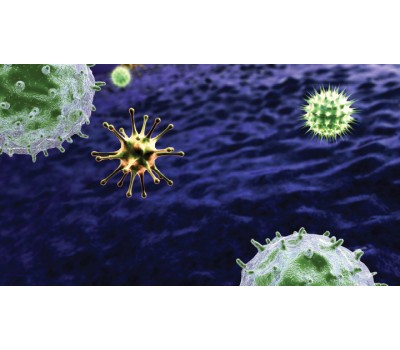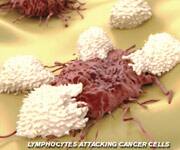A Common Virus That May Accelerate Immune

A major reason why our immune system fails with aging is that we lose vital naïve (virgin) immune cells while we accumulate excess levels of senile memory cells.1,2
Naïve immune cells are needed to respond to new malignancies and infectious agents,3whereas memory immune cells only respond to the original antigen, i.e. bacteria, virus, or cancer cell.4
Once our reserve of naïve immune cells is depleted, we become vulnerable to diseases that were fought off in our youth.
Some people suffer accelerated immune senescence that wreaks havoc throughout their body. These individuals are unable to fend off new invaders because of naïve celldepletion. They may also suffer systemic damage caused by inflammatory signals emitted from senescent memory cells.1
A growing body of evidence has identified a virus (cytomegalovirus) that causes us to more rapidly deplete vital naïve immune cells with the consequential buildup of excessive memory cells.1
A disconcerting 60 to 90% of us are estimated to harbor this insidious virus.5 Fortunately, there are steps one can take to help offset the age-accelerating effects inflicted by the cytomegalovirus (CMV) and thus retain more youthful immune function.
There is a limit as to how many naïve immune cells our bodies normally produce and this number declines with age.6-9 Once a naïve cell is exposed to an antigen, it converts to a memory type immune cell that only responds to the same virus, bacteria, or other foreign agent.4,10
When we develop certain chronic viral infections, our immune system goes into constant overdrive, producing high levels of naïve cells that convert into memory cells upon exposure to new copies and strains of the virus replicating in our cells. Unfortunately, there are only limited numbers of these vital naïve immune cells our bodies can naturally make.
Those inflicted with HIV suffer an accelerated form of aging as their immune system works to fight the virus, despite the advent of anti-HIV drugs.11,12 Hepatitis C infection creates this same problem.13 The breakthrough news about hepatitis C is that new drugs are curing up to 90% of those infected.14
Most of us, however, are not infected with hepatitis C or HIV. What the vast majority of us do harbor in our bodies is the cytomegalovirus. Lab tests revealed that it is present in approximately 60% of the general population, and in 90% of those over the age of 80.5
The insidious property of cytomegalovirus (CMV) is that it leads to the continuous production of viral proteins that have the ability to establish secondary infections withdiffering CMV strains.15-17 The deadly consequence that has been observed is continuous stimulation (and subsequent depletion) of naïve cells and excess accumulation of dysfunctional memory cells leading to the development of accelerated immune senescence.18-20
Unless one is immune compromised, most of us infected with CMV are asymptomatic—or so we think.21 The harsh reality is that chronic CMV infection is associated with frailty,cognitive decline, and arterial occlusion—hallmark pathologies of “normal” aging processes.22,23
CMV Shown To Shorten Life Span

CMV infection can increase mortality (death) rate in otherwise healthy, older individuals. This is most clearly seen by an increase in vascular deaths and immune senescence.22,24
One study found that high CMV antibody levels (associated with CMV exposure) were independently associated with a 179% greater mortality rate over a five-year period.22Another study showed a 35% increase in cardiovascular disease mortality in those with elevated CMV indicators.25 In still another study, CMV reduced life expectancy by 3.7 years after adjusting for other factors.24
What scientists are finding is that chronic CMV infection “exhausts” the immune system. It does this by depleting naïve cells needed to ward off new CMV strains and leaving behind a large population of pro-inflammatory senile memory cells.18,26
Of interest, however, was a study on long-lived family members whose offspring enjoy a30% reduced mortality rate.27 These rare individuals, genetically enriched for longevity, were less susceptible to the characteristic CMV-driven impairments of immune function. This study showed that CMV infection was strongly associated with an age-related reduction in vital naïve T-cells and accumulation of memory T-cells in the general population, but not in members of long-lived families.27 These long-lived individuals also showed lower pro-inflammatory status as measured by C-reactive protein. This study implies that by initiating strategies to boost naïve T-cell populations and suppress excessmemory cells, one might derive some of the enhanced longevity benefits enjoyed by genetically programmed long-lived individuals.
CMV Adversely Affects Cognitive Thinking
T-helper cells are needed to help initiate an immune attack against foreign invaders. Regulatory T-cells (also known as suppressor T-cells) turn down immune responses, preferably after the pathogen has been brought under control.28
For optimal immune health, one should have approximately one to four T-helper cells for every one regulatory T-cell.29,30 As a result of normal aging, regulatory T-cell counts elevate,31,32 while T-helper counts decline.33 Certain cancers appear able to boost regulatory T-cell counts in order to protect themselves against an immune attack.34-36
A study published in 2014 evaluated 360 adults (aged 60-103) and found that those with higher CMV activity had an 8-fold increased risk of an inverted T-helper/regulatory T-cell ratio, meaning they had more regulatory T-cells than T-helpers.37
These human study subjects with inverted T-helper/regulatory T-cell ratios hadimpairments in some cognitive dimensions and more functional disability and dependency compared to subjects with higher T-helper counts and lower regulatory T-cell counts.
Humans with lower T-helper counts and higher regulatory T-cell counts die sooner.38 It is thus important for aging individuals and certain cancer patients to take aggressive steps to maintain higher youthful levels of T-helper cells and keep regulatory T-cell counts from increasing too much.
CMV MAY SPEED UP IMMUNE SENESCENCE
 |
- An aging immune system fails because, as we age, the body loses vital naïve immune cells and accumulates excess levels of senescent memory cells.
- This makes us vulnerable to diseases that were easily overcome in youth.
- Growing evidence shows that a virus called cytomegalovirus (CMV) depletes naïve immune cells and infects approximately 60 to 90% of people.
- CMV infection can shorten the life span of otherwise healthy older adults. Bolstering natural killer cell (NK) activity may suppress CMV.
- A four-month course of a compound called enzymatically modified rice bran, along with a 60-day course (800 mg/day) of an over-the-counter drug called cimetidine, can help reduce the CMV burden in the body and boost antiviral activity.
- A commonly used Chinese herbal extract called cistanche can also influence antiviral components and help increase naïve T-cells and NK cells.
How CMV Inflicts So Much Damage
CMV attacks the endothelial lining of our arteries, which explains the high prevalence ofvascular death seen in those with active CMV infection.39-45
Immune cells are highly dependent on telomerase activity in order to maintain youthful function.46 CMV causes immune cells to lose telomerase activity.47-49
CMV also forces vital naïve immune cells to be used to suppress active infection. The result is accelerated immune senescence.50-52 As naïve immune cells decline, aging humans lose their natural protection against bacteria, viruses, and cancer.
Naïve cells are lost to normal aging, making CMV infection particularly deadly in the elderly.24,53
Active CMV infection is present in virtually all glioblastoma (fatal brain tumor) patients.54As we reported in 2013, administering an anti-CMV drug (valganciclovir) to glioblastoma patients improves two-year survival rates by more than 3-fold.55 However, this drug has side effects56,57 and costs about $50,000 annually. It is thus, not yet suitable for most normal aging people.
Another way to suppress CMV may be to bolster natural killer cell activity. An important function of natural killer (NK) immune cells is to destroy virus-infected cells throughout our body.58
“An effective defense against CMV in immune competent subjects requires the participation of NK cells and T-lymphocytes… It has been shown that CMV chronic infection in old individuals is associated with accumulations of late-differentiated CD8 T-cells, characteristic of CD8 T-cell immunosenescence, and with the development of an ‘Immune Risk Phenotype’ (IRP), predictive of early mortality in the elderly indicating that this virus is a major driving force of T-cell immunosenescence.”82
Reference: Current Opinion In Immunology—January 2014, “Shaping Of NK Cell Subsets By Aging.”
CMV-INDUCED IMMUNE CELL EXHAUSTION
 |
Immune cells used to suppress chronic infections like cytomegalovirus (CMV) become senile or “exhausted” over time.18,50,59,60
As people accumulate exhausted T-cells, an adverse consequence is that the senile cells emit pro-inflammatory cytokines that exacerbate the chronic inflammation observed in elderly persons.61,62 These individuals suffer higher mortality.63,64
The deficit of naïve immune cells combined with over accumulation of exhausted T-cells decreases the efficacy (antibody response) of vaccinations.65-67
Persistent CMV infection and the consequent accumulation of pro-inflammatory exhausted T-cells are associated with increased risk of coronary heart disease, impaired vascular function, vascular inflammation, and endothelial dysfunction.39,41,68-72 This all leads to increased blood pressure and contributes to atherosclerosis.73
An accumulation of exhausted T-cells has been seen in persons suffering from rheumatoid arthritis and other chronic inflammatory conditions.74,75
A strong body of evidence, mostly published over the past few years, indicates that persistent CMV infection and the accumulation of senile (exhausted) T-cells initiates and accelerates a broad array of age-associated and inflammatory diseases.76-81
An Immune Cell That Destroys CMV
Cytomegalovirus (CMV) invades cells throughout the body and spews out copies that infect other cells.83
The first line of defense against virus-infected and malignant cells is our natural killer (NK) cells.84-87 Young individuals have high levels of functional natural killer immune cells, but this declines with aging.88-90
In elderly subjects, decreased NK cell activity is associated with an increased incidence and severity of viral infections, which explains why 90% of older people show CMVinfection compared to about 60% of the general population.5
Healthy NK function is critical in eliminating transformed cells before a viral infection ormalignancy develops.59,91,92 NK cells are involved in immune regulation, antimicrobial immune responses, and elimination of senescent cells that otherwise cause chronic inflammation.59
The age-related decrease in healthy NK cell function is likely to have wider implications for the health of older adults than currently understood by the mainstream. If an aging person is to control debilitating and deadly CMV replication, maintaining more youthful NK function would appear to play a critical role, as would restoration of the naïve immune cell population.

“…several features of the aging process, such as the reduced efficacy of vaccination, the appearance of senescent cells, and the higher rates of fungal infection may be attributable in part to the decline in NK cell function that accompanies human aging. If true, then developing strategies to prevent, delay, or reverse NK cell immunesenescence may be one way by which to improve the health of older adults.”59
Reference: Ageing Research Reviews—September 2013
“The Impact Of Aging On Natural Killer Cell Function And Potential Consequences For Health In Older Adults.”
Suppressing CMV Infection
Immune compromised people, such as HIV patients, organ transplant recipients given immune-suppressing drugs, and certain cancer chemotherapy patients are particularly vulnerable to acute CMV infection.93-96 These individuals facing blindness,97 pneumonia,98and possible death from an uncontrolled CMV infection are prescribed a drug likevalganciclovir that is highly effective in controlling viral replication.99-101
One of the side effects of this drug is bone marrow suppression, which can hastenimmune senescence.102 That’s because immune cells are formed in our bone marrow where they are released into the bloodstream for further differentiation into specific disease-fighting cells like macrophages and NK cells. Valganciclovir is therefore not recommended for most CMV-infected individuals who are asymptomatic.
Since we know that NK cells hunt down virus-infected cells and eliminate them, it makes sense to take steps to boost the functionality of our aging NK cells to suppress CMV activity.
Enhanced NK cell function alone will not likely eradicate CMV, but it can downregulate active CMV infection to reduce the damage inflicted on the body and theoretically reduce the number of naïve immune cells that will be used up fighting it.103
In as much as aging itself causes a decline in functional NK activity, initiating a four-month course of an NK-boosting compound like enzymatically modified rice bran offers an intriguing approach to reducing the CMV burden in an aging body.104-106
To further boost antiviral activity, consider taking 800 mg each night of the over-the-counter drug cimetidine for 60 continuous days. This drug is approved for relieving heartburn, but a side benefit is that it boosts the number of T-helper immune cells while suppressing excess regulatory T-cells.107-110
As people age, and/or contract an illness such as cancer, they often produce too manyregulatory T-cells111,112 that prematurely shut down needed immune activity.113-118 Aging also results in a decline of T-helper cells that initiate immune responses to virus-infected and cancer cells.119 Cimetidine can be obtained without a prescription at your local pharmacy at low cost.
T-helper cells are required for the immune system to react to new infections and malignancies.120,121 They help activate the secretion of antibodies and macrophages to destroy ingested microbes and help activate cytotoxic T-cells to kill virus-infected target cells. To fully appreciate the importance of T-helper cells, you may know that HIV invades and destroys T-helper cells.122 As T-helper cell counts decline, AIDS patients become vulnerable to a host of opportunistic infections.123,124
A four-month course of enzymatically modified rice bran combined with a 60-day regimen of cimetidine makes sense to reduce CMV activity and reverse markers ofimmune senescence such as dysfunctional NK cell activity, reduced T-helper counts, and excess numbers of regulatory T-cells.104-107
A commonly used herbal extract in China called cistanche has been recently shown to favorably influence multiple antiviral immune components, including increasing the number of naïve T-cells and NK-cells.125 Cistanche is a low-cost nutrient that should be taken daily in the dose of 210 mg, preferably with 1,000 mg of Reishi mushroom extract, to provide broad spectrum protection against the many factors involved in immune senescence.
There Is Not Yet Universal Consensus On CMV And Immune Senescence

Not all published scientific papers agree that CMV infection accelerates immune senescence. The topic is currently being debated by immunologists around the world.126The studies supporting the pathologic impact of CMV on immune status are compelling, as is the data associating active CMV infection with shortened human life spans. But as critics accurately point out, “association” is not always the same as “causation.”
For an aging human concerned about their health and longevity, it does not necessarily matter if CMV is accelerating immune senescence. That’s because maturing individuals are already suffering a decline of naïve T-cells, reduced T-helper cells, loss of NK cell activity, accumulation of worn out memory cells (that emit chronic inflammatory signals), and an increase in regulatory T-cells. So initiating daily supplementation with 210 mg ofcistanche, a 60-day course using 800 mg daily of cimetidine, and a four-month course using 500 mg daily of enzymatically modified rice bran makes sense for anyone over age 35 (and sometimes younger individuals with certain immune deficits).
I’m ending this article with information about cimetidine side effects.
Aging humans who choose not to take cimetidine should still consider initiating low-costcistanche daily, along with a four-month regimen of enzymatically modified rice bran.
CIMETIDINE: DRUG INTERACTIONS AND SIDE EFFECTS
 |
We describe here potential side effects for certain individuals taking cimetidine.
From past experience, I know the risk of any side effect will preclude some Life Extension members from considering even a 60-day course of cimetidine at the moderate dose of 800 mg at bedtime.
By way of analogy, I have dealt with aging men who have stubbornly high levels of C-reactive protein, which is an inflammatory factor associated with greater incidence of vascular disease, dementia, and certain cancers.127-132
Low testosterone levels are associated with higher C-reactive protein levels.133-136 An unwarranted fear of prostate cancer caused many of these men to not elevate their testosterone levels. The outcomes in some cases were tragic.
When it comes to cimetidine, the benefit is boosting T-helper immune cell counts and lowering excessregulatory T-cell levels.107-110 Aging people often have elevated regulatory T-cells that interfere with optimal immune defenses. Mortality rates are higher in those with surplus regulatory T-cells in relation to T-helper cell counts.
I hope members who could benefit from a 60-day course of cimetidine (800 mg a night) will not be dissuaded by side effect risks that are usually manageable if they occur at all.
Significant Drug Interactions137,138
Cimetidine is a known inhibitor of many isozymes of the cytochrome P450 enzyme system, including but not limited to CYP2D6, 3A4 and 1A2 isoenzymes, which can cause increases in plasma concentrations of certain drugs when cimetidine is ingested.137,139
A short list of important, clinically relevant drug interactions include:102
- Warfarin (Coumadin®), an anticoagulant;
- Sildenafil (Viagra®), a PDE5 inhibitor for erectile dysfunction;140
- Phenytoin (Dilantin®), an anticonvulsant;
- Propranolol (Inderal®),a beta-blocker used to reduce blood pressure and heart rate);141
- Nifedipine (Procardia®), a Ca2+-channel blocker primarily used to reduce blood pressure);
- Diazepam (Valium®), an anti-anxiety medication;142
- Several tricyclic antidepressant drugs, lidocaine, theophylline (anti-asthmatic) and metronidazole (antifungal).141
Dosage of these drugs and other similarly metabolized drugs, particularly in patients with significant renal (kidney) and/or hepatic (liver) disease, may require adjustment when starting/stopping cimetidine to maintain therapeutic blood levels.
In patients with poor liver143 or kidney function,144 as well as elderly patients at risk for neuropsychiatric illness,145 cimetidine dosage should be reduced to 300 mg every 12 hours, and further reduction may be necessary depending upon patient tolerability.
Close monitoring of prothrombin time (PT)146 is recommended with the anticoagulant warfarin (Coumadin®), and careful adjustment of the anticoagulant dose may be necessary with cimetidine treatment.
Aging men with pre-existing erectile dysfunction using sildenafil (Viagra®) should be aware that cimetidine boosts drug exposure by almost 60%,147 so men should strongly consider using a reduced dose of sildenafil (Viagra®) if concomitantly using cimetidine.
Sexual Side Effects In Men
Starting at the time of prescription use of cimetidine in the 1970s, multiple case reports began to appear in the peer-reviewed literature concerning sexual side effects, including loss of libido and erectile dysfunction.148,149 In addition, many reports of breast tenderness and tissue growth in men, known as gynecomastia,150 were published.151,152 Conservative post-marketing surveillance data suggests that the incidence of gynecomastia may be as high as one out of every 25 male patients treated with cimetidine for high stomach acid.153
These sexual side effects are not surprising since cimetidine is known to interfere with sex hormone binding sites in androgen responsive tissues,154 as well as increase prolactin levels and interfere with the peripheral activity of sex hormones like dihydrotestosterone (DHT).155
Since the risks for male sexual side effects and gynecomastia appear to increase with cimetidine dosages of 1,000 mg daily in men over the age of 40 years (though some men may experience sexual dysfunction within a short time of starting cimetidine at lower doses),149,152 older men should avoid doses of cimetidine in excess of 800 mg daily and treatment regimens longer than 60 days.
Summary
The immune system begins to shut down as we age due to the loss of vital naïve immune cells and an accumulation of excess levels of older memory cells, which makes us vulnerable to disease. Research shows that about 60 to 90% of adults harbor a virus calledcytomegalovirus (CMV), which depletes naïve immune cells. CMV may increase mortality in healthy older adults.
Enzymatically modified rice bran, taken over the course of four months, along with a 60-day course of cimetidine, may reduce CMV and boost antiviral activity. Cistanche, a common Chinese botanical extract, can also influence antiviral components and help increase naïve T-cells and NK cells.
By William Faloon
Article extracted from Life Extension Magazine January 2015
Scientific Journal References (PDF)


Social Login